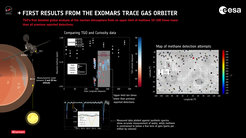ExoMars finds no methane
Are there significant amounts of methane in the Martian atmosphere? Data from the ExoMars Trace Gas Orbiter raise new questions.
About a year ago, the space probe ExoMars Trace Gas Orbiter (TGO), a joint project of the European and Russian space agencies, began its scientific measurements from the orbit of Mars. Since then, the probe has not detected methane in the atmosphere of our neighboring planet, as the teams of two TGO instruments including researchers from the Max Planck Institute for Solar System Research (MPS) report in the journal Nature. The new measurement data are a surprise. Especially since NASA’s Mars rover Curiosity had repeatedly found methane near the ground in the past, many researchers expected to be able to detect the gas in the rest of the atmosphere as well. Methane is considered a possible indicator of life on Mars.

With more than 95 percent, carbon dioxide is the main component of the Marsian atmosphere, followed by small amounts of nitrogen, argon, oxygen, carbon monoxide, and other trace gases. Whether the latter also include methane and in what concentration, is one of the most discussed questions in Mars research. Since in the Earth's atmosphere methane is primarily produced by microorganisms on the ground, it is believed to be possible that on our neighboring planet too the gas could have a biological origin. However, other sources must also be considered, such as certain geochemical reactions in the Martian rock.
The first discoveries of methane in the atmosphere of Mars date back about 16 years. In the following years, both ground-based investigations and measurements by ESA’s Mars Express spacecraft confirmed the discovery. NASA's Curiosity rover, which has been exploring Gale crater since 2012, also proved successful in finding methane: At ground level, the methane concentration there fluctuates constantly between 0.24 and 0.65 ppb (parts per billion).
"Assuming our understanding of the atmospheric chemistry of Mars to date is correct, methane has a lifetime of several hundred years there," explains MPS scientist Dr. Paul Hartogh, who is part of the team of the TGO instrument ACS (Atmospheric Chemistry Suite). Above all, the incidence of ultraviolet radiation and reactions with the hydroxyl radical contribute to the degradation of methane. Due to its chemical stability, methane produced near the ground should gradually spread evenly over the entire atmosphere of Mars and be measurable even at great altitudes.
However, the current data from the NOMAD (Nadir and Occultation for Mars Discovery) and ACS instruments on board TGO paint a different picture: despite the high sensitivity of the measurements, which can detect concentrations of 0.05 ppb, the scientists were unable to find methane.
Mars researchers are now looking for ways to reconcile the seemingly contradictory results of TGO and Curiosity. For example, it is conceivable that a previously unknown mechanism is at work in the atmosphere of Mars where it degrades methane. Other explanations take a closer look at Curiosity's measurement data. Is it true that the entire Gale crater has the same methane concentration as measured by the rover? Only then should ACS, too, be able to detect the gas. Or do the data have to be interpreted much more locally? For example, there were fears that Curiosity itself might have emitted methane. In this case, the quantities of methane that reach the rest of the atmosphere are likely to be well below the detection limit of TGO.
MPS scientist Paul Hartogh brings another explanation into play: It is possible that there are methane hydrates under the regolith layer at the bottom of Gale crater, such as those found in permafrost soils of the Arctic on Earth. These could be mixed with other gases and materials in the Martian soil. If the methane is released, it could diffuse into the Mars regolith and be deposited there. The pressure of the moving rover could then release the gas. The total quantities would be too small to be detected by TGO.
Nevertheless, the Gale crater will be the target of future methane measurements by TGO.












